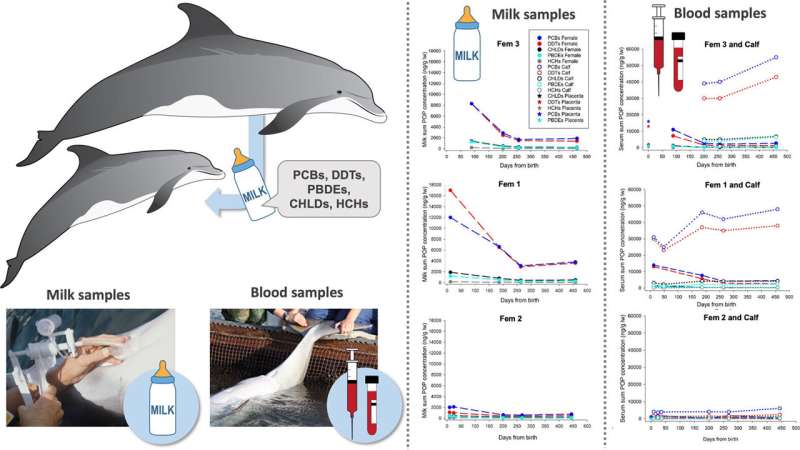November 8, 2023 report
This article has been reviewed according to Science X's editorial process and policies. Editors have highlighted the following attributes while ensuring the content's credibility:
fact-checked
peer-reviewed publication
trusted source
proofread
Baby dolphins found to receive high doses of persistent organic pollutants from their mothers' milk

A team of marine biologists from the National Oceanic and Atmospheric Administration, working with a pair of colleagues from the Naval Information Warfare Center Pacific, has found that dolphin calves born to mothers in the U.S. Navy Marine Mammal Program consume milk that contains high amounts of persistent organic pollutants (POPs).
For their paper published in the journal Science of The Total Environment, the group studied milk produced by dolphin mothers and POP levels in blood samples from calves in the naval based program.
Prior research has shown that toxic lipophilic POPs, such as PCBs, DDTs, CHLDs, HCHs and PBDEs, can accumulate in the blubber of marine mammals, leading to a wide variety of ailments and sometimes death. Most have a tendency to disrupt the normal functioning of the endocrine system. Prior research has also shown that marine mammals that live at the top of the food chain (such as dolphins) wind up with the highest amounts of POPs in their systems due to bioaccumulation up the food chain.
In this new study, the research team wondered about the possibility of POPs being consumed by baby dolphins nursing on mother's milk. To find out if this occurs and if so, in what quantities, the researchers looked to dolphins that are part of the U.S. Navy's Marine Mammal Program in San Diego Bay. The dolphins in the program live a semi-wild existence—they are free to swim around in the bay, but are confined by fences. The program exists to study ways that dolphins might be used for military purposes.
To learn more about their exposure to POPs, the researchers collected milk samples from six mother dolphins and blood samples from their calves over a period of 460 days. Both types of samples were tested for POP levels.
In studying their data, the research team found high levels of POPs in the mothers' milk and increasing amounts of POPs in the blood of their offspring. By the time calves were weaned, the researchers found, they had higher levels of POPs in their fatty tissue than their mothers. They suggest much of the reason for the high levels of POPs in the milk was due to the mothers continuing to hunt and eat prey, which have POPs in their bodies, while nursing young.
The research team concludes by suggesting that their results indicate that dolphins in many parts of the sea are at risk of medical problems and death due to ingestion of POPs. They note that their findings also suggest orcas are likely in a similar situation because they too continue to hunt and eat prey while they are nursing their young.
More information: Dawn P. Noren et al, The dynamics of persistent organic pollutant (POP) transfer from female bottlenose dolphins (Tursiops truncatus) to their calves during lactation, Science of The Total Environment (2023). DOI: 10.1016/j.scitotenv.2023.167888
Journal information: Science of the Total Environment
© 2023 Science X Network





















